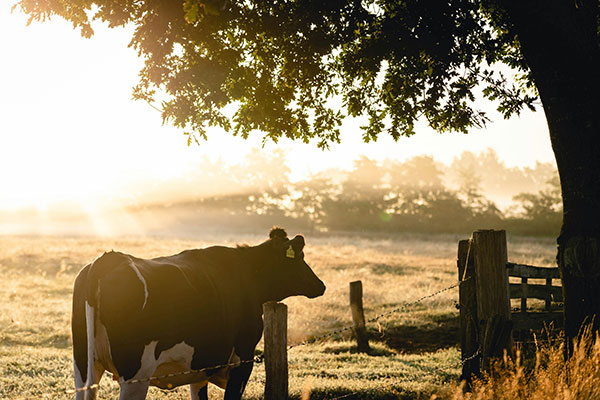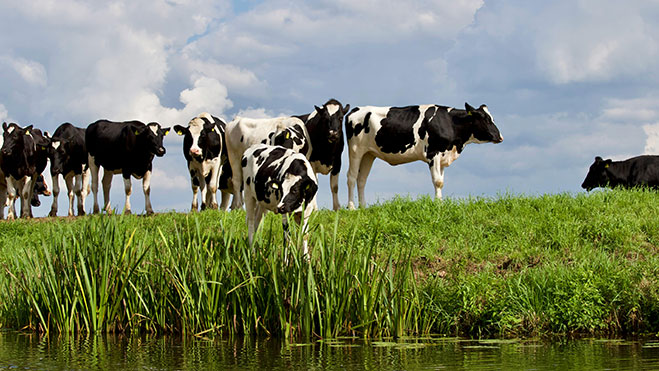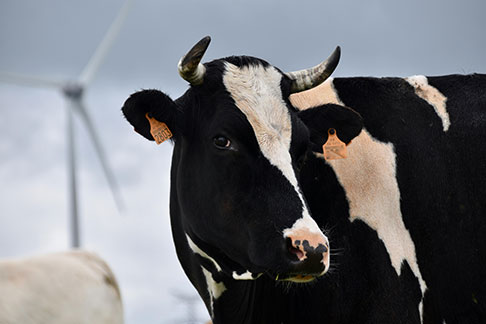What is Rumen Protected Lysine
A Key to Modern Ruminant Nutrition
Rumen Protected Lysine (RPL) is a revolutionary tool in ruminant nutrition, designed to deliver the essential amino acid lysine directly to the small intestine of dairy cows, sheep, and goats. Unlike standard feed additives, RPL is a sophisticated biochemical solution that addresses a unique challenge in ruminant digestion. By ensuring lysine bypasses rumen microbial degradation, RPL unlocks significant potential in milk production, metabolic health, reproductive efficiency, and environmental sustainability. This comprehensive guide explores the challenges of ruminant digestion, the innovative technology behind Rumen-Protected Lysine, its benefits during critical life stages, practical applications, and answers to common questions about lysine supplementation in dairy farming.
Why RPL Matters for Dairy Farmers: Lysine is a critical building block for protein synthesis, especially for milk production in dairy cows. Without adequate lysine, cows cannot achieve their full genetic potential, leading to reduced milk yields, health challenges, and inefficiencies. RPL bridges this gap, making it an essential component for modern dairy farms aiming to optimize performance and sustainability. Whether you’re a farmer or a nutritionist, understanding RPL can transform your approach to dairy cow nutrition.
protected lysine
Lysine is one of the most important essential amino acids for protein synthesis in ruminants, but in the rumen it is rapidly degraded by microbes. Rumen-Protected Lysine (RPL) is a technology designed to bypass this problem by applying a protective coating that allows lysine to escape rumen degradation and be absorbed in the small intestine. Supplementing dairy cow diets with RPL improves milk yield and protein content, enhances metabolic health, reduces nitrogen excretion, and supports overall farm efficiency. Selecting high-quality RPL products and using them strategically, especially during the transition and early lactation periods, is key to maximizing benefits.
Understanding Ruminant Digestion: The Microbial Challenge
To fully appreciate the value of Rumen Protected Lysine (RPL), it’s crucial to understand the complex digestive system of ruminants. The rumen, a 200-liter anaerobic fermentation vat, hosts trillions of microorganisms, including bacteria, protozoa, and fungi. These microbes form a symbiotic relationship with the cow: they ferment fibrous feeds (like hay or silage) that the cow cannot digest alone, while the cow provides a stable, warm, nutrient-rich environment.
A primary product of rumen fermentation is Microbial Crude Protein (MCP). Rumen microbes capture dietary protein and non-protein nitrogen (e.g., urea) to synthesize their own protein. As microbes are flushed from the rumen, they are digested further down the gastrointestinal tract, serving as the cow’s main protein source. However, MCP’s amino acid profile is fixed by the microbial population, not the cow’s specific needs, creating a challenge for delivering essential amino acids like lysine.
The Lysine Problem: In typical dairy diets (e.g., corn and soy-based), lysine is often a limiting amino acid, restricting protein synthesis and impacting milk production. Rumen Protected Lysine addresses this by ensuring lysine reaches the small intestine, where it can be absorbed effectively.
Why Lysine is Critical for Dairy Cows
Protein synthesis in dairy cows is an “all-or-none” process. Picture building a wall with LEGO bricks, where each color represents a different amino acid. If you run out of blue bricks (lysine), construction halts, regardless of how many other bricks remain. In dairy cattle fed standard diets, lysine and methionine are typically the first and second limiting amino acids for milk protein synthesis. This makes lysine supplementation through RPL vital for maximizing dairy performance.
Impact on Milk Production: Lysine is a key component of casein, the primary protein in milk. Without sufficient lysine, the mammary gland’s protein synthesis machinery operates below capacity, reducing milk protein content and overall yield. By addressing lysine deficiencies, RPL enhances milk quality and quantity, benefiting both farmers and dairy processors.
The Challenge of Unprotected Lysine in Ruminant Diets
When unprotected lysine is added to a cow’s feed, it enters the rumen and is rapidly degraded by microbes through deamination. During this process, microbes strip the amino group (NH₃) from lysine for their own protein synthesis, using the remaining carbon skeleton for energy.
As a result, little to no lysine reaches the small intestine, leaving the cow deficient and the investment in supplementation wasted.

Why Rumen Protected Lysine is Essential
bypasses rumen degradation, delivering lysine directly to the small intestine for absorption, ensuring cows receive the full benefit of lysine supplementation. This makes RPL a critical tool for overcoming the limitations of ruminant digestion.
Bridging the Bypass Protein Gap with Rumen-Protected Lysine
Some dietary proteins, known as Rumen Undegradable Protein (RUP) or bypass protein, naturally escape rumen degradation. Feedstuffs like heat-treated soybean meal or distillers grains are rich in RUP, but their amino acid profiles are often suboptimal. For example, distillers grains, a common RUP source in North America, are notoriously low in lysine. This creates a lysine gap—the difference between what the cow needs for peak production and what’s provided by microbial protein and bypass protein.
How RPL Helps: Rumen-Protected Lysine fills this gap, delivering lysine to the small intestine to support optimal milk production, metabolic health, and reproductive performance. By addressing the lysine gap, RPL ensures dairy cows can perform at their best.
How Rumen Protected Lysine Works
The Science of Bypass Technology
The technology behind Rumen Protected Lysine (RPL) focuses on one goal: making lysine invisible to rumen microbes while ensuring it’s available for absorption in the small intestine. This is achieved through microencapsulation, where lysine is coated with a protective layer. The effectiveness of RPL depends on the quality of this coating.
Key Encapsulation Technologies for Rumen Protected Lysine
- Lipid Encapsulation: The most common method, where lysine is coated with saturated fatty acids (e.g., hydrogenated vegetable oils). These fats are solid at rumen temperature and resist microbial lipase enzymes in the rumen’s neutral pH (6.0-6.8). In the small intestine, pancreatic lipase and bile salts break down the coating, releasing lysine for absorption.
- pH-Sensitive Polymers: A “smart-release” technology using polymers stable in the rumen’s neutral pH. In the acidic abomasum (pH 2.0-3.0), these polymers dissolve, releasing lysine for intestinal absorption.
- Matrix Encapsulation: Lysine is embedded in a fat or wax matrix, making it physically inaccessible to rumen microbes, ensuring safe passage to the small intestine.
Why Technology Matters: High-quality encapsulation ensures RPL delivers lysine effectively, maximizing its benefits for dairy cows.
Characteristics of High Quality Rumen Protected Lysine Products
Not all Rumen Protected Lysine (RPL) products are created equal. A superior RPL product must meet these criteria:
– High Rumen Stability: Withstands rumen hydration, microbial activity, and contractions for hours, ensuring a high percentage of lysine bypasses the rumen.
– High Intestinal Bioavailability: The coating must break down efficiently in the small intestine, releasing absorbable lysine.
– Physical Durability: The coating must endure feed processing, including transport, augering, and Total Mixed Ration (TMR) mixing, without fracturing.
– Palatability and Consistency:
Uniform particle size and lysine concentration ensure consistent delivery, while palatability prevents reduced feed intake.
Choosing the Best RPL: Selecting a high-quality RPL product is crucial for maximizing the benefits of lysine supplementation. Work with a ruminant nutritionist to find the right RPL for your dairy farm’s needs.

Benefits of Rumen Protected Lysine
Unlocking Dairy Cow Potential
By delivering lysine to the small intestine, Rumen Protected Lysine (RPL) triggers a cascade of benefits that enhance dairy cow performance across the production cycle.
Boosting Milk Production and Component Yield
The most immediate benefit of RPL is its impact on milk production:
– Driving Milk Protein Synthesis: Milk protein is ~80% casein, which relies heavily on lysine. When lysine is limited, the mammary gland cannot produce casein efficiently. RPL increases milk protein percentage, benefiting farmers (via higher milk payments) and processors (via improved cheese yield).
–
Increasing Milk Volume: By enhancing metabolic efficiency and protein status, RPL supports higher milk yields, as energy isn’t wasted on excess nitrogen processing.
Enhancing Metabolic Efficiency and Cow Health
RPL improves the cow’s metabolic engine: –
Liebig’s Law (Barrel Analogy): Protein synthesis is limited by the shortest “stave” (amino acid). If lysine is deficient, other amino acids are wasted. RPL ensures lysine availability, improving feed and protein efficiency.
– Reducing Liver Stress: Excess amino acids produce toxic ammonia, which the liver converts to urea, taxing energy reserves. RPL balances amino acid profiles, reducing ammonia and liver workload, especially critical for transition cows.
Promoting Environmental Sustainability
RPL supports sustainable dairy farming:
– Reducing Nitrogen Excretion: Excess amino acids lead to urinary nitrogen, which turns into ammonia gas, contributing to air and water pollution. RPL shifts nitrogen to the stable fecal pathway, aligning with precision feeding goals and reducing environmental impact.
Critical Periods for Rumen Protected Lysine Transition and Lactation
While Rumen Protected Lysine (RPL) benefits cows throughout lactation, its impact is most significant during the transition and early lactation phases.
Transition Period: Setting the Stage for Success
The transition period (three weeks before to three weeks after calving) is a time of hormonal and metabolic stress. RPL offers substantial benefits:
– Fueling Colostrum and Mammary Development: Pre-calving, cows produce high-protein colostrum and undergo mammary gland growth, both requiring lysine. RPL ensures these processes are supported, improving colostrum quality and milk production postpartum.
– Mitigating Negative Protein Balance: Pre-calving, Dry Matter Intake (DMI) drops, and post-calving, milk production surges before DMI recovers. This creates a protein deficit, forcing cows to break down muscle. RPL spares muscle tissue, maintaining body condition and reducing metabolic disease risks.
Lactation: Maximizing Peak and Persistency
During lactation, RPL helps cows reach their genetic potential:
– Maximizing Peak Milk Yield : Peak lactation (45-90 days in milk) sets the lactation curve. Each 1 kg increase in peak milk yields 200-250 kg more milk over the lactation. RPL ensures lysine isn’t a limiting factor, maximizing peak yields.
– Improving Reproductive Performance : Poor transition periods lead to body condition loss, delaying cyclicity and reducing conception rates. RPL improves protein status, supports immune function, and enhances uterine health, reducing days open and boosting herd profitability.
Practical Applications of Rumen-Protected Lysine in Dairy Farming
To maximize the benefits of Rumen Protected Lysine (RPL), dairy farmers should:
– Work with Nutritionists: Collaborate with a ruminant nutrition expert to determine the optimal RPL inclusion rate based on diet composition and herd needs.
– Monitor Feed Processing : Ensure RPL products are handled carefully to maintain coating integrity during mixing and transport.
– Evaluate Herd Performance : Track milk protein content, milk yield, and reproductive metrics to assess RPL’s impact and adjust supplementation as needed.
– Focus on Transition Diets : Prioritize RPL during the transition period to support colostrum production and minimize metabolic stress.
Call-to-Action : Ready to boost your dairy herd’s performance with Rumen Protected Lysine? Contact a dairy nutritionist or explore high-quality RPL products to optimize your feeding program.
Frequently Asked Questions About Rumen Protected Lysine (RPL)
What is Rumen Protected Lysine (RPL) and Why is it Important for Dairy Cows?
Rumen-Protected Lysine (RPL) is a feed additive designed to deliver the essential amino acid lysine to the small intestine of ruminants like dairy cows, bypassing rumen microbial degradation. In dairy nutrition, lysine is often a limiting amino acid, meaning its deficiency restricts milk protein synthesis. RPL enhances
milk production, improves metabolic health, and supports reproductive efficiency by ensuring adequate lysine availability. This technology is vital for optimizing dairy cow performance and achieving sustainable dairy farming practices.
How Does Rumen Protected Lysine Work in Ruminant Digestion?
Rumen Protected Lysine (RPL) uses microencapsulation technologies, such as lipid or pH-sensitive polymer coatings, to protect lysine from rumen microbes. These microbes typically degrade unprotected lysine through deamination, rendering it unavailable to the cow. RPL’s protective coating ensures lysine passes through the rumen to the small intestine, where it is absorbed for protein synthesis. This process addresses the lysine gap in ruminant diets, boosting milk yield and cow health.
What Are the Benefits of Rumen Protected Lysine for Milk Production?
Rumen Protected Lysine (RPL) significantly enhances milk production in dairy cows by increasing milk protein content and overall milk volume. Lysine is a key component of casein, which makes up 80% of milk protein. By supplying adequate lysine, RPL supports higher casein synthesis, leading to improved milk protein percentages and cheese yield. Additionally, RPL improves metabolic efficiency, freeing energy for milk synthesis and maximizing peak lactation yields.
How Does Rumen Protected Lysine Contribute to Environmental Sustainability?
Rumen-Protected Lysine (RPL) promotes environmental sustainability by improving nitrogen efficiency in dairy cows. By balancing the amino acid profile, RPL reduces excess amino acid breakdown, which lowers ammonia production and urinary nitrogen excretion. Urinary nitrogen is volatile and contributes to air and water pollution. RPL shifts nitrogen to the more stable fecal pathway, aligning with precision feeding goals and reducing the environmental footprint of dairy farming.
When Should Rumen Protected Lysine Be Used in Dairy Cow Diets?
Rumen Protected Lysine (RPL) is most effective during the transition period (three weeks before to three weeks after calving) and early lactation. During transition, RPL supports colostrum production and mammary gland development, both of which require high lysine levels. In early lactation, RPL maximizes peak milk yield and prevents negative protein balance, reducing muscle breakdown and metabolic stress. Continuous use throughout lactation can further enhance milk protein and reproductive performance.
What Makes a High Quality Rumen Protected Lysine Product?
A high-quality Rumen Protected Lysine (RPL) product features high rumen stability, ensuring lysine bypasses microbial degradation, and high intestinal bioavailability for efficient absorption. It should have a durable coating to withstand feed processing and rumen contractions, as well as consistent particle size and palatability to maintain feed intake. Technologies like lipid encapsulation or pH-sensitive polymers are key to effective RPL products, ensuring optimal delivery of lysine supplementation to dairy cows.
What is rumen-protected lysine (RPL) and how does it differ from regular lysine?
RPL is formulated with a protective coating that prevents microbial breakdown in the rumen, allowing lysine to reach the small intestine for absorption.
What are the main benefits of supplementing dairy cows with RPL?
Key benefits include increased milk yield, higher milk protein content, improved nitrogen efficiency, and better metabolic balance.
When is RPL supplementation most effective in dairy cows?
RPL is particularly beneficial during the transition period and early lactation when protein requirements are highest.
What factors determine the quality of an RPL product?
Important factors include rumen stability, intestinal digestibility, uniform particle size, coating technology, and resistance to feed processing conditions.
How should RPL be included in dairy cow diets?
Inclusion rates should be determined by a nutritionist based on cow performance, diet composition, and production goals. It is usually added as part of a balanced amino acid nutrition strategy.
Conclusion: RPL as a Cornerstone of Sustainable Dairy Nutrition
Rumen Protected Lysine (RPL) is far more than a simple supplement—it’s a transformative technology that addresses a fundamental biological constraint in high-producing dairy cows. By delivering lysine precisely where it’s needed, RPL unlocks the cow’s genetic potential, driving milk production, improving metabolic health, enhancing reproductive success, and promoting environmental sustainability. This shift from feeding the rumen to truly nourishing the cow makes RPL a vital tool for modern dairy farming. Start incorporating lysine supplementation today to elevate your herd’s performance and profitability.
Useful content:


